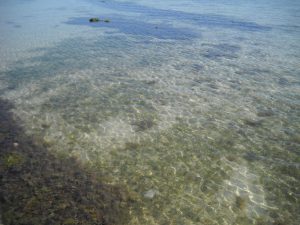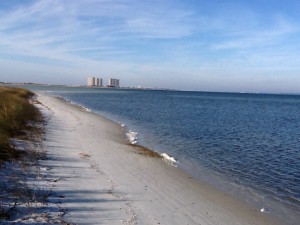Most everyone knows the importance of submerged seagrass in our coastal estuaries. It has been estimated that 80% of the commercial and recreational important marine species depend on seagrasses for at least part of their life cycle. One acre of submerged seagrass can produce 10 tons of leaves, support 40,000 fish, and 50 million invertebrate species. Not everyone in the panhandle lives on the coast, but many who live inland enjoy fishing there, so the concern for the health of our grassbeds does extend inland.
In the Pensacola Bay area, the decline of seagrass was first reported in the 1950s. A 95% decline occurred between 1950 and 1980. The decline in local bay scallop and shrimp over the years has been attributed to the decline of these grassbeds. Aerial surveys have shown steady decreases in acres until 2003. From 2003 until 2010, there was an 8.4% increase in seagrass acreage in the Pensacola Bay System. All bodies of water showed increases except Santa Rosa Sound and Big Lagoon, which had slight losses in seagrass coverage. The most recent reports from an FWC study (2010-2015), suggest the seagrasses in the Big Lagoon and Santa Rosa Sound area have increased 13%.
Despite these recent gains, and anecdotal reports of “healthy seagrass”, many of the historic beds have not recovered. Historically, seagrass restoration efforts have not been very successful. Natural restoration seems to be the best target at the moment. To do this, you will need to reduce the stressors that caused the declines in the first place. Some of the possible stressors include: dredging, trawling, decreased water clarity, prop scarring, dock shading, and armored shorelines – to name a few.
To this end, a citizen science project was developed by a partnership with the University of West Florida and the Florida Sea Grant Extension Programs in Santa Rosa and Escambia counties. Volunteers who live on, or near, these bodies of water were trained to monitor the seagrass beds near their homes. Eleven 1-nautical mile square grids were set up in Big Lagoon and 55 were marked for Santa Rosa Sound. Volunteers selected beaches within one of these grids to survey. In 2018, five of the Big Lagoon and six of the Santa Rosa Sound grids were monitored. Within their grids, volunteers selected four locations to monitor once a month between May and October. Using snorkels, volunteers placed a 0.25m2 PVC square (quadrat) on the bottom over the grass. The percent coverage was estimated and species of grass within identified and recorded. Volunteers recorded whether drift algae was present on the grasses (these could be a problem for them) and a list of any marine animals they may have found. They also collected a water sample to be analyzed for total suspended solids and nutrients by students at the University of West Florida. UWF students also visited sites during the year to collect data on salinity, temperature, dissolved oxygen, nitrites, nitrates, ammonia, total phosphorus, and pH.
So how did the first year go?
Pretty good!
The average percent coverage of seagrass for all locations was between 60-70%, some locations in Santa Rosa Sound were 100% coverage for their stations. The percent coverage of the epiphytic drift algae was between 2-8%. There was no real difference between Santa Rosa Sound and Big Lagoon in seagrass coverage however there was for the epiphytic drift algae – Big Lagoon had more. The UWF environmental data also found a higher concentration of chlorophyll a in Big Lagoon. This suggest either more runoff into Big Lagoon, or the runoff has more nutrients in it. Overall nutrients were relatively low. There was a decrease in salinity as the rain increased. The more common species of seagrass are not fans of low salinity, but Widgeon grass (Ruppia maritima) is – and we did see increases in this species as we moved into September, again – probably due to lower salinities.
We will continue to monitor these grassbeds for several years and really hope we see signs of natural restoration.
REFERENCES
Caffrey, J. 2018. Unpublished report on seagrass monitoring.
Lewis, M. J.T. Kirschenfeld, T. Goodheart. 2016. Environmental Quality of the Pensacola Bay System: Retrospective Review for Future Resource Management and Rehabilitation. U.S. Environmental Protection Agency, Gulf Breeze FL. EPA/600/R-16/169.
- Our Environment: Part 11 – We Need Water - July 7, 2025
- Our Environment: Part 10 – Improving Agriculture - June 20, 2025
- Marine Creatures of the Northern Gulf – Snails and Slugs - June 20, 2025


